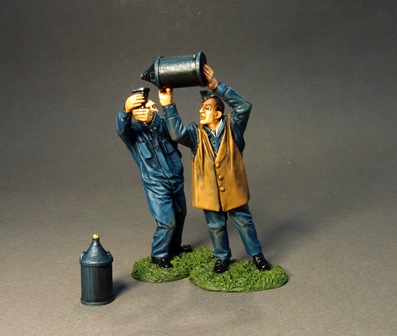
KNIGHTS OF THE SKIES
ALLIED GROUNDCREW AND ACCESSORIES
BGC-16
Refuelling The Camel
(3pcs)
US$78
**PLEASE NOTE THIS SET IS SPECIFICALLY DESIGNED TO BE USED WITH THE SOPWITH CAMEL AEROPLANE**
By early 1917 the British Shell company had a complete monopoly on the supply of aviation fuel
to both the British and French armed forces,
and also controlled the distribution of gasoline in France
via the 'pool' system in which petrol companies 'pooled'
their gasoline in Britain for transport by Shell tankers to ports across the channel in France,
where the Shell company then established canning centres for the onward supply of
gasoline in jerry cans to British and French military forces.
They maintained this monopoly until the end of 1917,
when the arrival of the US forces brought their own gasoline supply network
and for the first time gasoline pumps to replace cans.
But Shell aviation fuel was so ubiquitous by this time that contemporary British references to
aviation fuel of this period are often made just to "Shell A"
(the 'A', presumably, for 'Aviation' or 'Aircraft').
The Sopwith Camel shot down 1,294 enemy aircraft during World War I,
more than any other Allied fighter. However,
it was so difficult to fly that more men lost their lives
while learning to fly it than using it in combat. A total of 5,490 Camels were built.
The pilot, engine,
armament and controls were all crammed into a seven-foot space at the front of the airplane.
This gave the plane a phenomenal performance,
but it also made the plane very tricky to fly.
Additionally, the plane’s wood and fabric construction and lack of protection for the fuel tank made the Camel
(like most WWI aircraft)very susceptible to fire.
Moreover, the poor state of pilot training during 1916-1917 meant that
the average life expectancy of an English pilot was little more than two weeks.
The Sopwith Camel needed a very specific fuel mixture.

To start at the beginning of the fuel/air cycle we can look at the elementary carburetor
that was located on the end of the crankshaft at the rear of the engine.
An air intake pipe came in from each side of the engine cowl to the carburetor.
A fuel line delivered fuel through a metering needle.
The pilot's throttle controlled an air valve and the fuel metering needle.
A fine adjustment of this needle allowed control of the fuel to provide correct mixture at altitude.
The fuel/air mixture then passed down the hollow crankshaft to the crankcase
where it was thoroughly mixed by the rotating engine parts.
It was then ducted from the crankcase through an external inlet manifold to the top of the cylinder.
The burnt mixture was passed directly out of the cylinder to atmosphere with no ducting.
To ensure an adequate supply of fuel to the engine in all maneuvers the fuel
from the fuselage-mounted tank was pressurized by an air pump.
On some aircraft this was engine-mounted pump,
on others such as the camel the pump was driven by a small propeller mounted on a wing strut just above the fuselage.
(Note this on the Camel on the right fuselage-to-wing strut above the cockpit).
The pilot also had a cockpit mounted pump used when starting the engine.
The lubricating oil was also delivered through the crankshaft,
a relatively easy as the plumbing was easily attached to the interior of the fixed crankshaft.
From here it was directed through drilled passageways to the various components that required lubrication.
A well known feature of Rotary engines was its use of castor oil.
With the fuel and oil mixed together in the crankcase it was important that
the fuel not dissolve the oil and ruin its lubricating qualities.
The perfect choice was pharmaceutical-quality castor oil---it would stand the heat and centrifugal force,
and its gum-forming tendency were irrelevant in a total-loss lubrication system.
An unfortunate side effect was that pilots inhaled and swallowed a considerable amount of the oil during flight,
leading to persistent diarrhea.
This also accounts for the pilot's use of a flowing white scarf---not for a dashing image,
but to wipe goggles clear of the persistent oil mist flowing past the cockpit.
We now accept PAYPAL,
to purchase your figures please send your order by e-mail to
inquiry@johnjenkinsdesigns.com
after checking that everything is available,
you will be billed via PAYPAL.
your order will be shipped on confirmation of payment.
worldwide airmail 12%
(minimum postage us$10)
JOHN JENKINS DESIGNS
UNIT 6H, TOWER 1,
KING LEY IND. BUILDING,
33-35 YIP KAN STREET,
WONG CHUCK HANG,
HONG KONG,
tel/fax; 852 2553 9313
